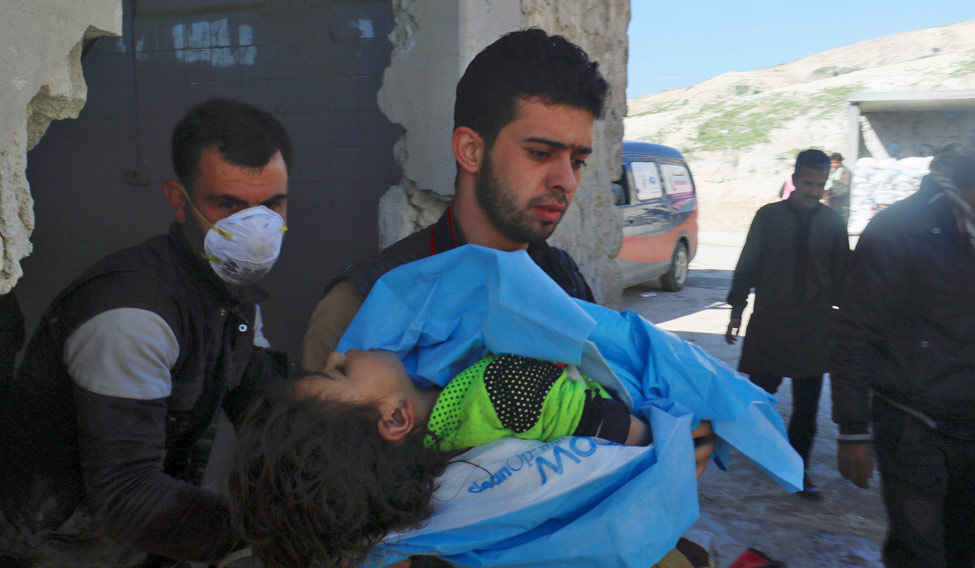A suspected chemical attack on a rebel-controlled town, Khan Sheikhoun, in Syria's Idlib province, killed scores of people, including children, on Tuesday. Many videos from the attack site show victims struggling to breathe and foaming at the mouth. Doctors treating the victims of the chemical attack have reportedly told media that the symptoms include vomiting, foaming at the mouth, unconsciousness and muscle spams. According to reports, constricted pupils and slow heart rate among victims point at poisoning by a man-made organo-phosphorus compound sarin, which belongs to a class of lethal chemical weapons—nerve agents.
Supporting the suspicion, Dr Shajul Islam, an aid worker in northern Syria, took to Twitter to post the videos of the victims of the gas attack, saying that non-reactive pupils of victims indicates an "organophosphate attack".
Do u still doubt that #Sarin is being used on us? Non-reactive pinpoint pupils! We have samples. Will anyone care!? Who will stop it?#Syria pic.twitter.com/WmhDZgLVA6
— Dr Shajul Islam (@DrShajulIslam) April 4, 2017
10 minute video of sarin attack in #syria. Feel free to use footage to make awareness https://t.co/pJNWK9vSfX
— Dr Shajul Islam (@DrShajulIslam) April 4, 2017
The G nerve agents, thus named because they were first synthesised by German scientists, include extremely toxic tabun (GA), sarin (GB), soman (GD), and cyclosarin (GF). Deadly in doses of above 0.5 milligrams, sarin gas, apparently, is 500 times more deadly than cyanide. Though Syria has suffered chemical attacks before, if confirmed, it would be the deadliest chemical attack in the country since sarin gas killed hundreds of people in Ghouta, near Damascus, in August 2013.
Marking the beginning of an era of chemical warfare, on April 22, 1915, the German army released 150 tonnes of chlorine gas on Allied forces, killing more than 1,100 soldiers and injuring many more. As part of global chemical arms race, many countries shifted their focus to discovering and developing chemicals as possible weapons. In 1938, a team of German scientists developed sarin, a colourless and odourless gas, as a pesticide. However, it did not take much time for the Nazis to realise the potential of sarin gas as a more toxic agent than chlorine gas.
Chlorine gas is a pulmonary irritant that damages the respiratory tract by turning to extremely poisonous hydrochloric acid in the lungs, leading to internal burning and drowning due to reactionary release of water in the lungs. Though chlorine is not very toxic, it is the effect it has on respiratory system than makes it fatal. Sarin is a lethal nerve gas that does not kill directly by poisoning, but instead, interferes with the normal functioning of nerves and neurotransmitters. For example, if your eyes are dry, a nerve would tell another nerve through a neurotransmitter to release a little water on to your eye to make it moist. Once the message is conveyed and mission accomplished, an enzyme comes along to break down the neurotransmitter. This is where a nerve agent interferes with the process and blocks the enzyme from demolishing the neurotransmitter. The result: neurotransmitter continues to give the message repeatedly, making your eye water uncontrollably. Thus, a nerve agent could turn your own nervous system against you, making different parts of body do things that are otherwise normal, in an uncontrolled way.
Being heavier than air, sarin gas settles near the surface and enters the body through inhalation or by being absorbed through the skin. Usually, the intensity of sarin poisoning is determined by the amount of sarin a person was exposed to, how a person was exposed to it and the duration of exposure. Depending on it, symptoms appear within seconds after exposure to sarin vapour, and within minutes, if the contamination was through liquid sarin. If the exposure level does not kill a person, then the recovery does not take much time and is usually complete. The initial symptoms of sarin poisoning include runny nose, watery eyes, pinpoint pupils, blurred vision, sweating and muscle twitches. Longer exposure could cause chest tightness, cramps, nausea, vomiting, involuntary defecation and urination, convulsions and respiratory failure possibly leading to death. Immediate medical attention could help in recovering from sarin exposure. However, to be effective, the antidotes available must be used quickly.
Though developed by Germans, sarin gas was first used as a chemical weapon in 1988 when former Iraqi president Saddam Hussein unleashed the deadly gas, along with sulphur mustard, on unsuspecting ethnic Kurds, killing around 5,000 people, in the northern town of Halabja. However, sarin gas became a household name after the members of religious cult Aum Shinrikyo carried out the deadly sarin attack on Tokyo's subway system, killing about a dozen commuters and injuring more than 6,000, in 1995.





